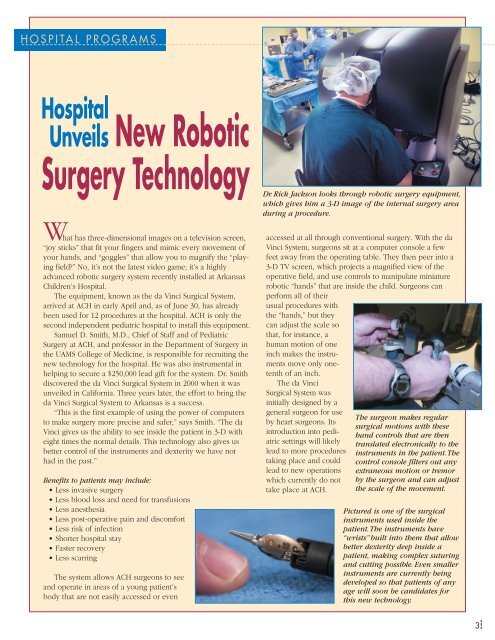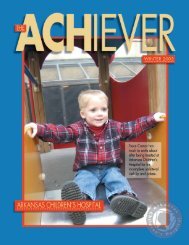Summer 2003 - Arkansas Children's Hospital
Summer 2003 - Arkansas Children's Hospital
Summer 2003 - Arkansas Children's Hospital
Create successful ePaper yourself
Turn your PDF publications into a flip-book with our unique Google optimized e-Paper software.
HOSPITAL PROGRAMS<br />
<strong>Hospital</strong><br />
Unveils New Robotic<br />
Surgery Technology<br />
Dr. Rick Jackson looks through robotic surgery equipment,<br />
which gives him a 3-D image of the internal surgery area<br />
during a procedure.<br />
What has three-dimensional images on a television screen,<br />
“joy sticks” that fit your fingers and mimic every movement of<br />
your hands, and “goggles” that allow you to magnify the “playing<br />
field?” No, it’s not the latest video game; it’s a highly<br />
advanced robotic surgery system recently installed at <strong>Arkansas</strong><br />
Children’s <strong>Hospital</strong>.<br />
The equipment, known as the da Vinci Surgical System,<br />
arrived at ACH in early April and, as of June 30, has already<br />
been used for 12 procedures at the hospital. ACH is only the<br />
second independent pediatric hospital to install this equipment.<br />
Samuel D. Smith, M.D., Chief of Staff and of Pediatric<br />
Surgery at ACH, and professor in the Department of Surgery in<br />
the UAMS College of Medicine, is responsible for recruiting the<br />
new technology for the hospital. He was also instrumental in<br />
helping to secure a $250,000 lead gift for the system. Dr. Smith<br />
discovered the da Vinci Surgical System in 2000 when it was<br />
unveiled in California. Three years later, the effort to bring the<br />
da Vinci Surgical System to <strong>Arkansas</strong> is a success.<br />
“This is the first example of using the power of computers<br />
to make surgery more precise and safer,” says Smith. “The da<br />
Vinci gives us the ability to see inside the patient in 3-D with<br />
eight times the normal details. This technology also gives us<br />
better control of the instruments and dexterity we have not<br />
had in the past.”<br />
Benefits to patients may include:<br />
• Less invasive surgery<br />
• Less blood loss and need for transfusions<br />
• Less anesthesia<br />
• Less post-operative pain and discomfort<br />
• Less risk of infection<br />
• Shorter hospital stay<br />
• Faster recovery<br />
• Less scarring<br />
The system allows ACH surgeons to see<br />
and operate in areas of a young patient’s<br />
body that are not easily accessed or even<br />
accessed at all through conventional surgery. With the da<br />
Vinci System, surgeons sit at a computer console a few<br />
feet away from the operating table. They then peer into a<br />
3-D TV screen, which projects a magnified view of the<br />
operative field, and use controls to manipulate miniature<br />
robotic “hands” that are inside the child. Surgeons can<br />
perform all of their<br />
usual procedures with<br />
the “hands,” but they<br />
can adjust the scale so<br />
that, for instance, a<br />
human motion of one<br />
inch makes the instruments<br />
move only onetenth<br />
of an inch.<br />
The da Vinci<br />
Surgical System was<br />
initially designed by a<br />
general surgeon for use<br />
by heart surgeons. Its<br />
introduction into pediatric<br />
settings will likely<br />
lead to more procedures<br />
taking place and could<br />
lead to new operations<br />
which currently do not<br />
take place at ACH.<br />
The surgeon makes regular<br />
surgical motions with these<br />
hand controls that are then<br />
translated electronically to the<br />
instruments in the patient.The<br />
control console filters out any<br />
extraneous motion or tremor<br />
by the surgeon and can adjust<br />
the scale of the movement.<br />
Pictured is one of the surgical<br />
instruments used inside the<br />
patient.The instruments have<br />
“wrists” built into them that allow<br />
better dexterity deep inside a<br />
patient, making complex suturing<br />
and cutting possible. Even smaller<br />
instruments are currently being<br />
developed so that patients of any<br />
age will soon be candidates for<br />
this new technology.<br />
3

















